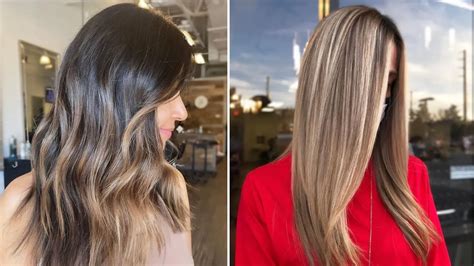Introduction
Are you looking for a transformative hair makeover that’s both stylish and low-maintenance? Consider the timeless techniques of balayage and highlights, each offering unique advantages. Join us as we delve into the world of hair painting, unraveling the intricacies and versatility of these two beloved methods.

What’s the Difference Between Balayage and Highlights?
Balayage:
- A French word meaning “to sweep,” balayage involves the freehand application of bleach or color to sections of hair.
- Creates soft, blended gradients that resemble sun-kissed highlights.
- The paintbrush strokes mimic natural hair growth patterns, resulting in a seamless look.
Highlights:
- A traditional technique where hair is separated into small sections and wrapped in foil.
- Bleach or color is applied to the strands, resulting in defined, contrasting streaks.
- Offers more control over placement and intensity, allowing for bolder, statement-making results.
Pros and Cons of Balayage vs Highlights
Balayage:
Pros:
- Natural-looking, blended results
- Less damage to hair compared to traditional highlights
- Suitable for all hair textures and lengths
Cons:
- Can be more time-consuming than highlights
- May not provide as much contrast as highlights
Highlights:
Pros:
- More precise placement and control
- Dramatic, contrasting results
- Can create a more vibrant, eye-catching look
Cons:
- Can be more damaging to hair
- May require frequent touch-ups to maintain contrast
Which Technique Is Right for You?
The choice between balayage and highlights depends on your desired look and lifestyle.
- For a natural, sun-kissed glow: Balayage is an excellent choice.
- For bold, statement-making highlights: Highlights will deliver the desired contrast and drama.
- For low-maintenance hair: Balayage’s blended nature means less frequent touch-ups compared to highlights.
- For damaged hair: Balayage’s gentler technique may be preferred to preserve hair health.
How to Maintain Balayage and Highlights
- Frequent trims: Regular trims remove split ends and prevent breakage.
- Color-safe shampoo and conditioner: Use products designed for color-treated hair to minimize fading.
- Heat protectant: Always use a heat protectant spray before styling to reduce damage.
- Avoid over-washing: Excessive washing can strip away color and damage the hair.
Tips and Tricks for Balayage and Highlights
- Consider your skin tone: Warm skin tones suit golden and copper tones, while cool skin tones complement ash and platinum shades.
- Add dimension: Incorporate multiple shades to create depth and texture.
- Start small: Begin with a few subtle highlights or a light balayage to gradually transition to a more dramatic look.
- Embrace your natural color: Don’t over-process your hair. Let your natural color shine through for a more authentic look.
Conclusion
Whether you crave the sun-drenched allure of balayage or the eye-catching impact of highlights, both techniques offer endless possibilities for hair transformation. By understanding the differences and benefits of each, you can make an informed choice that will enhance your personal style and empower your hair to shine. Embrace the art of hair painting and unleash your inner hair goddess today!
FAQs
Q: Which technique is more expensive?
A: The cost of balayage and highlights can vary depending on the salon, hair length, and desired look. Generally, balayage is more time-consuming and may be more expensive than traditional highlights.
Q: Can I do balayage or highlights at home?
A: While DIY balayage or highlights may be tempting, it’s highly recommended to seek professional services to ensure proper application and avoid damage.
Q: How long do balayage and highlights last?
A: Balayage and highlights typically last for several months, but the longevity depends on factors such as hair growth rate, color maintenance, and hair care habits.
